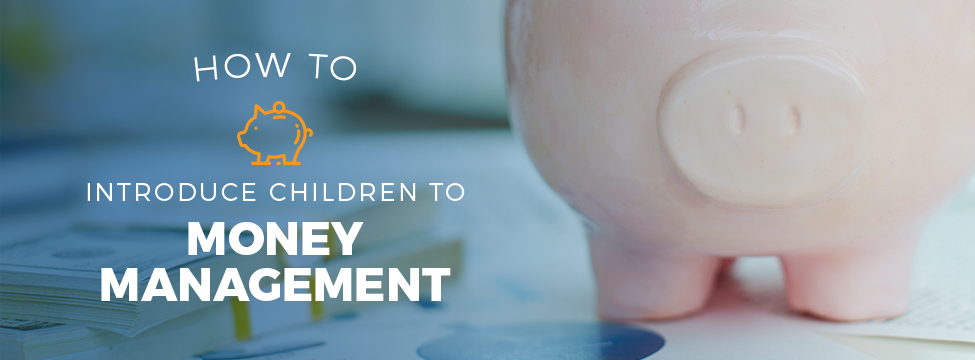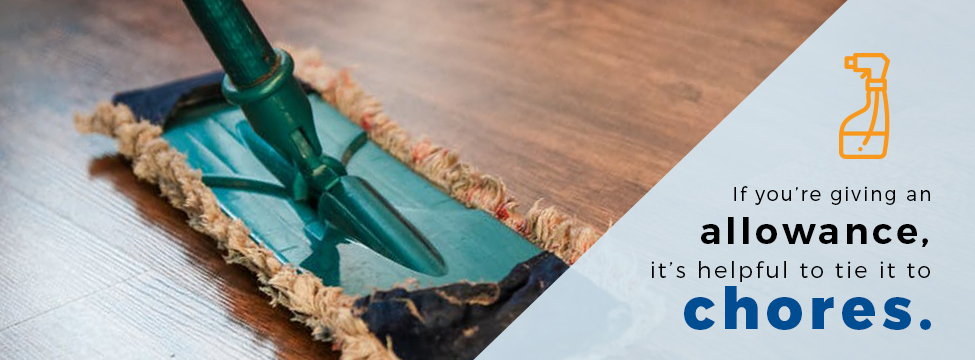How to Introduce Children to Money Management: Money Lessons for Kids

The most important life lessons often aren’t taught in schools. For example, few schools offer personal finance or money management courses to children. As a result, many people struggle with basic financial literacy. Teaching money management lessons to you children can be a great way to keep them from struggling as they get older.
Just 48 percent of people who took the National Financial Literacy Test earned a passing score. Test-takers between the ages of 10 and 14 earned an average score of 54 percent, while test-takers between the ages of 15 and 18 earned an average score of 60 percent.
It’s not only low scores on tests that suggest that more people need to learn how to manage money from a younger age. People’s perceptions of their financial status imply that more education is a must. According to a survey conducted by Pew Research Center, 53 percent of people rated their financial situation as fair or poor in December 2016.
As a parent, it’s up to you to help your children learn the basics of money early in life. Fortunately, money plays a significant role in everyday life, so there are plenty of opportunities to discuss it with your kids. Whether you have a toddler, a school-aged child or a teenager, here are a few ways to help your children master personal finance.
How to Introduce Children to Money
Since most people use money nearly every day, introducing your child to the concept shouldn’t be uncomfortable. If you take a close look at your daily habits, you will most likely find learning opportunities in several areas.
Since children are curious by nature, it’s likely that your kid will see you using money and ask you about it. That question gives you an opening to start a money discussion. Even if your child doesn’t ask about money, there are many times throughout the day when you have a chance to talk about it with your child.
For example, many children look at an ATM and think it’s a magic machine that gives mom or dad money. If your child sees you swiping your debit card at the machine and receiving cash from it, they might not understand the source and think it is always there for the taking. Instead, you can use a visit to the ATM as a chance to explain that you put the money you earn into an account and use your card to take out cash when you need it. You can also explain that there is a limited amount of money in the account and that you can’t simply get more when you want it.
When explaining to your child how money works, you want to keep the discussion age-appropriate. Younger kids, for example, might not fully grasp different denominations of coins or paper money. When presented with a penny, nickel or dime, toddlers often go for the nickel because it’s the biggest. Focus on teaching your kids about the concept of money first and then you can move on to how ATMs and banks work.

With that age group, you don’t necessarily want to focus on where the money comes from or how it is spent. Instead, concentrate on teaching your child the different names for coins and what each one is worth. You can introduce your toddler to coins and paper money by arranging coins in ascending order of worth on a table or floor. Have the child trace each coin on a piece of paper and color it, then write the value of the coin beneath the picture.
Another way to help your two or three-year-old child understand how money values work is to show him how many pennies are in one nickel or one dime. If your child already knows how to count, this can be a good practicing activity. Have your child count out five pennies, then give him a nickel instead. You can do the same with paper money, collecting five $1 bills and giving your child a $5 bill to illustrate the difference.
Important Money Management Lessons for Kids
Once your child has a grasp on how money is valued and what each coin or paper bill is worth, you can focus on specific money lessons and the basics of money management. Depending on the age of your child, these lessons can be in the form of play or real-life examples.
1. Money Lessons for Toddlers
Once your child is familiar with the various types of coins and paper bills, you can demonstrate how money works in everyday life by playing store. You can play the cashier, and your child can play the shopper. Give your child a certain amount of play money (or real cash if you prefer) and write prices on a variety of items, such as toys or groceries. Then, have your child try to buy the items using the money you provided.
2. Money Lessons for Preschoolers
Playing store with your toddler lays the groundwork for an important money management lesson. Since your child only gets a limited amount of play money, hewon’t be able to buy every item at the pretend store they might want. If your child has $5 to play with but wants to buy one $3 item and one $4 item,he’ll have to choose one or the other.
A toddler might be too young to grasp that lesson, but a preschooler (four or five-years-old) should be able to understand it. One good money lesson for preschool-aged children is that sometimes you need to delay a purchase or save up your money to buy something.
This is a good age to transition from pretend store to real store. If your child has seen something in the store that he wants, write down the item and its cost. Explain to your child that sometimes you have to wait to buy something you want since you have to save up the money.
Next, explain how your child can save the money for the item. If he has an allowance, show how many weeks’ worth of allowance is needed to pay for the item. You can introduce a jar or piggy bank at this stage to give your child a place to save the money for the item. Each week when your child adds more money to the jar, subtract the amount from the price of the toy, so your child can watch his progress.
This can also be a good time, especially for preschool-aged children, to discuss how money is earned. If you are giving an allowance, it is helpful to tie it to chores. This way, your child begins to grasp the idea of earning money through work. We’ll return to the idea of allowances later.
Once your child has saved enough money to buy the item, let him handle the transaction with the cashier. Have your child count out the money, hand it over and collect any change.

3. Money Lessons for School-Aged Kids
By the time a child is in elementary school, they can start to understand that seemingly similar items can sometimes cost different amounts. For example, a name-brand T-shirt might cost $20, while a store brand T-shirt only costs $5. Curious kids might ask you about this or make assumptions about products based on what they see on the price tag.
Now is a good time to teach your child how to be a smart shopper. For example, if you regularly buy the store-brand of a certain food or beverage, ask your child if he likes the taste of it (pick something you know your child likes). When he says yes, explain that you buy that item because it costs less than the name-brand, even though the quality is the same, or close to it.
Along with introducing your child to the price differences between branded items and generic items, you should show your child the value of comparison shopping. Stores often charge different amounts for the same product. If your child wants to buy a video game or toy, have him do online research to compare prices — with your supervision.
Your child might be amazed to find that the item costs $20 at store A, $25 at store B and $15 at store C. Ask your child where he would rather buy the product based on price.
4. Money Lessons for Preteens
You’ve gone over the basics of using money to buy items you need or want. By the time your child reaches ages 10 through 12, they’re likely ready to learn more about investing and how money can grow over time.
At this age, your child might have learned about compound interest in math class. Now is a good time to show him how it works in real life, by either opening an interest-earning savings account or having your child invest in stocks or mutual funds. Stress the fact that you end up with a lot more money if you start saving early, since the original amount you invested earns interest, as does any interest that gets added to the amount.
It’s not too early to have your preteen start saving for big financial goals. Age 16 is just a few years away, and college isn’t too far out. Point out that if he starts saving for a car or college education now, there will be a lot more money in the bank than if he waits until high school.
5. Money Lessons for Teenagers
Teens might not have as many financial responsibilities as adults, but they are rapidly getting to a point in their lives when they will have to make important money decisions. One lesson that teens need to learn is how to budget their money. Making and sticking to a budget will teach them to save for goals and avoid deep debt in the future.
A budget can be a particularly useful tool for a teenager who is working a part-time job and has a variety of money-related goals, such as saving for college, a car or prom. You can help your teen put together a budget by having him list his income, regular expenses, variable expenses and savings.
Ideally, the amount of your teen’s expenses shouldn’t be more than the income amount. If their expenses are more than his income, your teen will have to make some choices. For example, he might cut back on going out for lunch with friends or decide that it is cheaper to take the bus to work or school instead of driving.
The teenage years are also an ideal time to show your child how to manage a checking account and use a debit card wisely. A teen’s spending with a debit card is limited to the amount that is in the account. If he tries to overspend, it will either trigger overdraft (which costs money) or result in the card being declined.

How to Introduce an Allowance
Giving children an allowance is the subject of a great deal of debate. Some people feel that giving children money on top of paying for their food, clothing and other needs isn’t necessary. Others believe that an allowance is an effective tool for teaching your child how to manage money. About 70 percent of kids today earn an allowance.
Another subject of debate is when you should start giving an allowance and when you should stop. It is possible to start an allowance too early. For example, your child won’t gain much value from an allowance if you begin handing him pennies before he knows what those pennies are.
Generally speaking, an allowance can be a great way to teach your child financial basics. It’s often a good idea to tie the allowance to completing chores so that your child learns he needs to earn money.
Choosing which chores qualify for an allowance is up to you. You can have your child complete simple tasks, such as setting the table for meals, making the bed or wiping out the bathroom sink in exchange for an allowance. Have a chart that hangs on the wall and check off each chore as your child completes them. If all the boxes are checked at the end of the week, give your child the full allowance.
As your child gets older, the chores can get more complicated. You can encourage creativity and an entrepreneurial spirit by having your child pitch chore ideas and bid on an allowance amount. For example, a teenager might offer to mow the lawn weekly, in exchange for $10. A child who enjoys cooking might want to take on planning and preparing one family dinner a week, for $5 plus the cost of food.
You can introduce an allowance as soon as you start introducing your child to the concept of money. After showing your toddler the difference between pennies, nickels and dimes, you can give him a dime for listening and participating in the discussion.
You can also wait until your child is a bit older, such as preschool or kindergarten-aged, before introducing the concept of an allowance. At that age, you’re also beginning to show how money can buy items that they want. Along with introducing an allowance, add different jars or piggy banks for saving the money your child gets. As your child gets older, you can present the concept of saving allowance money in a bank account.
Share:
Disclosures
The material on this site was created for educational purposes. It is not intended to be and should not be treated as legal, tax, investment, accounting, or other professional advice.
Securities and Insurance Products:
NOT A DEPOSIT | NOT FDIC INSURED | NOT BANK GUARANTEED | NOT INSURED BY ANY FEDERAL GOVERNMENT AGENCY | MAY LOSE VALUE
